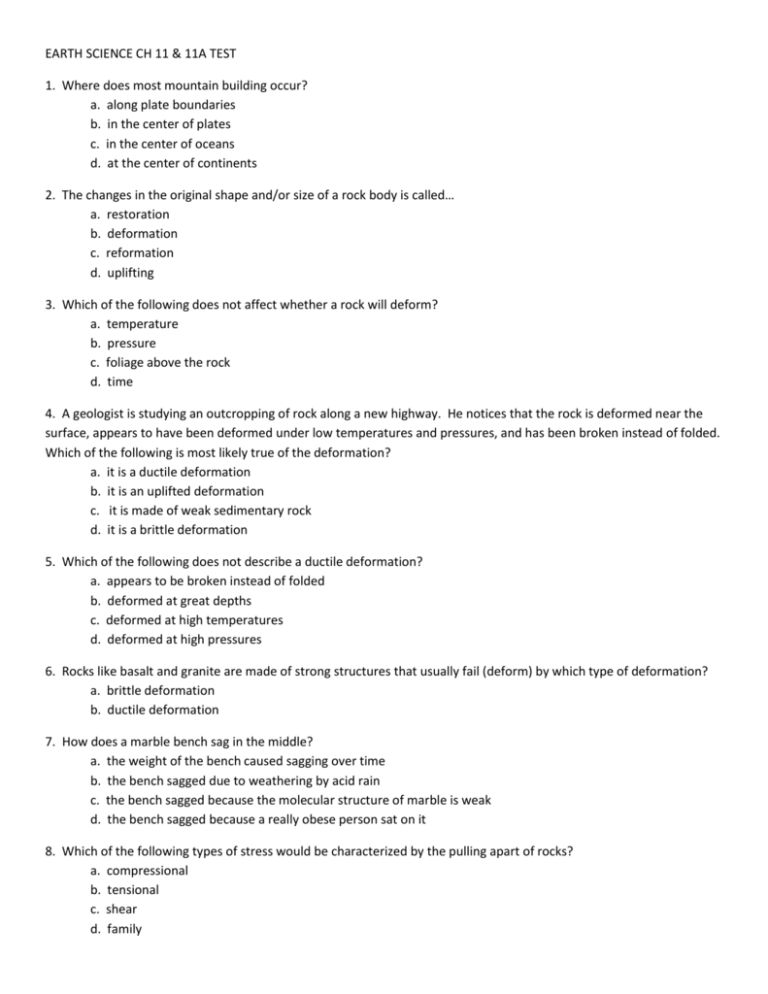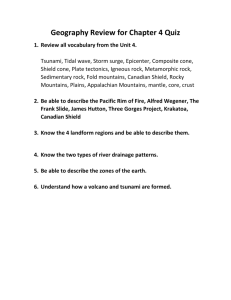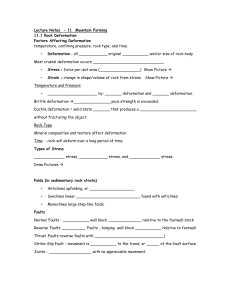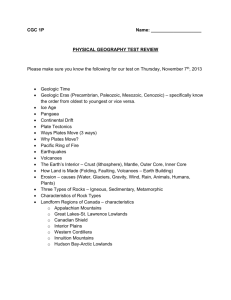EARTH SCIENCE CH 11 & 11A TEST 1. Where does most mountain
advertisement

EARTH SCIENCE CH 11 & 11A TEST 1. Where does most mountain building occur? a. along plate boundaries b. in the center of plates c. in the center of oceans d. at the center of continents 2. The changes in the original shape and/or size of a rock body is called… a. restoration b. deformation c. reformation d. uplifting 3. Which of the following does not affect whether a rock will deform? a. temperature b. pressure c. foliage above the rock d. time 4. A geologist is studying an outcropping of rock along a new highway. He notices that the rock is deformed near the surface, appears to have been deformed under low temperatures and pressures, and has been broken instead of folded. Which of the following is most likely true of the deformation? a. it is a ductile deformation b. it is an uplifted deformation c. it is made of weak sedimentary rock d. it is a brittle deformation 5. Which of the following does not describe a ductile deformation? a. appears to be broken instead of folded b. deformed at great depths c. deformed at high temperatures d. deformed at high pressures 6. Rocks like basalt and granite are made of strong structures that usually fail (deform) by which type of deformation? a. brittle deformation b. ductile deformation 7. How does a marble bench sag in the middle? a. the weight of the bench caused sagging over time b. the bench sagged due to weathering by acid rain c. the bench sagged because the molecular structure of marble is weak d. the bench sagged because a really obese person sat on it 8. Which of the following types of stress would be characterized by the pulling apart of rocks? a. compressional b. tensional c. shear d. family B . A . C D . MATCHING: Match the illustrations above with their fold types below. 9. Anticline 10. Syncline 11. Monocline 12. Overturned A B C D MATCHING: Match the illustrations above with their fault types below. 13. Strike-slip 14. Normal 15. Reverse 16. Thrust 17. Fault-block mountains often exhibit two types of characteristics. Which of the following best describes fault-block mountains? a. a tall pointed peak called a horst with a bowl-shaped area called a graben b. a tall pointed peak called a graben with a bowl-shaped area called a horst c. a short rounded peak called a horst with a v-shaped area called a graben d. a short rounded peak called a graben with a v-shaped area called a horst 18. Circular or elongated structures produced by upwarping are called… a. dominant mountains b. basin mountains c. dome mountains d. fault-block mountains 19. What is the process of crustal fragments colliding with a continental plate and becoming stuck to or embedded into the plate called? a. convergence b. divergence c. accretion d. uplifting 20. How did the Himalayan Mountains form? a. India collided with Asia b. India is subducting under Asia c. Asia is subducting under India d. Asia and India are sliding past each other 21. Which of the following is an example of mountains created by a divergent boundary? a. Himalayas b. Rockies c. Alps d. Mid-Atlantic Ridge 22. A mountain ridge that has rocks that are unlike those in the surrounding area are called a. accreted mountains b. terrane mountains c. inverted mountains d. diverged mountains 23. What is isostasy? a. the gravitational balance of floating continental plates b. the equal movement of floating continental plates over the mantle c. the balancing of movements of plates in subduction zones to plates in divergent zones d. the balance between building mountains and eroding mountains 24. Which of the following mountains are correctly matched with their continents? I. Andies – South America II. Himalayas – India III. Urals – Russia IV. Alps – Switzerland a. b. c. d. I, II and III only II and IV only II, III and IV only I, II, III and IV TRUE/FALSE: Mark A for True or B for False on your answer sheet. 25. 26. 27. 28. 29. The state rock of NC is marble. There is no state fossil for NC. Only Macon, Watauga, and Buncombe counties have landslide information on record. NC has multiple gold deposits. The state mineral of NC is the emerald.






